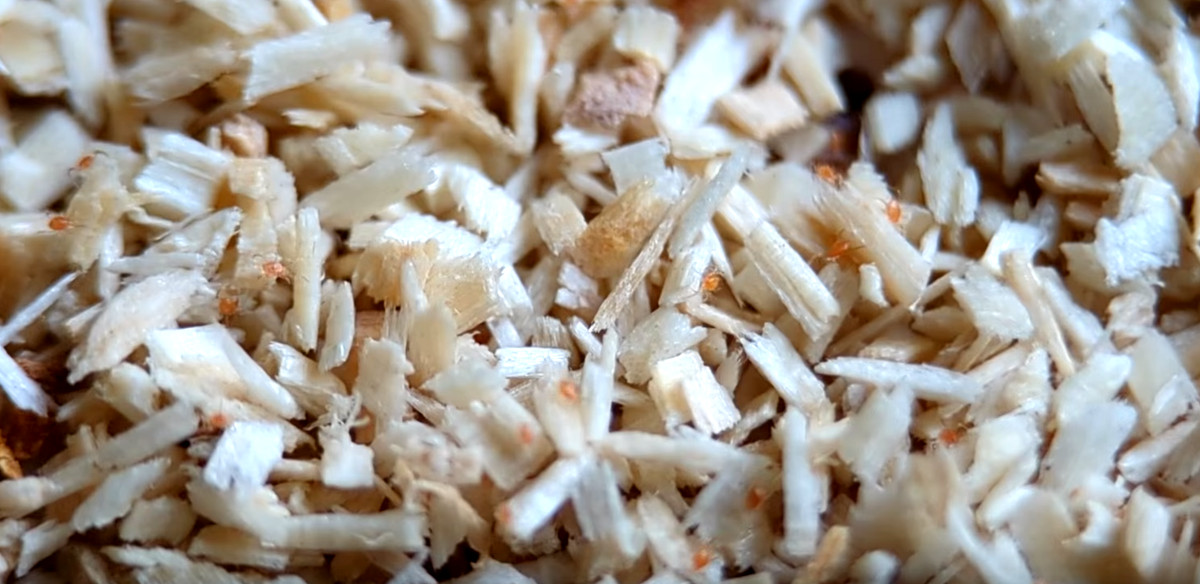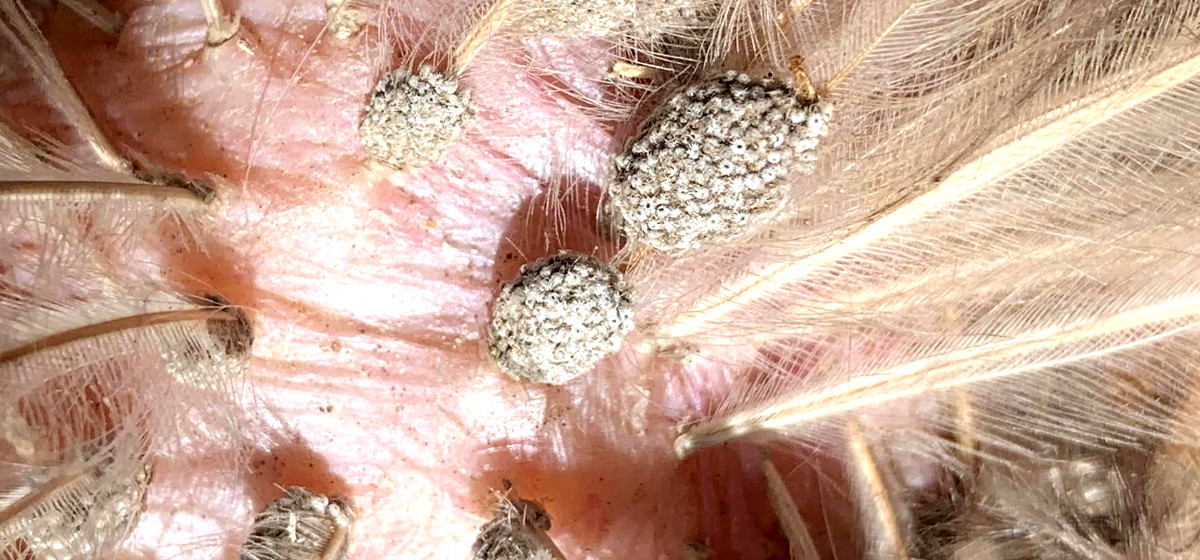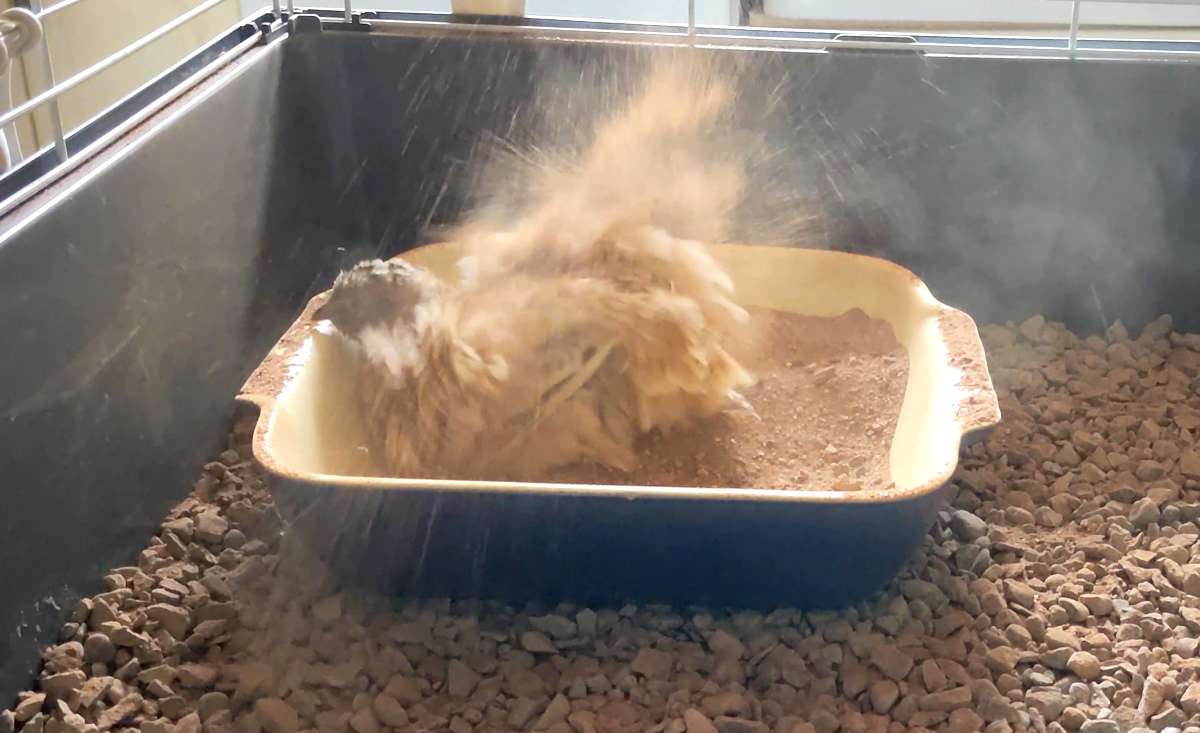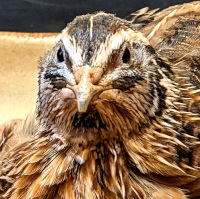The pests and parasites on and inside quail and how to identify and treat them.

Quail farming is a rewarding endeavour, but like any livestock, these birds are susceptible to pests and parasites that can jeopardise their health and productivity.
Table of Contents
While quail are generally hardy birds, they can be susceptible to certain critters that can impact their well-being.
The parasites that affect quail come in two types, those that live on the surface of the bird, called ectoparasites and those that live inside the bird, called endoparasites.
The symptoms of parasitic infections:
Keeping a watchful eye on your quail is key. Look for signs like:
- Loss of appetite and weight
- Scratching and irritated skin
- Decreased egg production or growth rates
- Dull feathers and feather loss
- Pale and loss of colour
- Rough scaly legs
- Diarrhoea or bloody droppings
- Listlessness and inactivity
Below: Some parasites are visible to the naked eye, you can just see poultry mites, especially after they have fed.
Which parasites affect Quail?
Keeping your quail healthy and happy involves protecting them from common pests and parasites.
Here's a table of the common pests and parasites help you identify and manage these threats:
| Pest/Parasite | Description | Signs of Infestation | Treatment Methods |
|---|---|---|---|
| Mites: Scaly leg, Red mite, Northern fowl mite, Depluming mite | Tiny, blood-sucking creatures that cause irritation, skin damage, and feather loss. | Scaly, crusty legs, reduced egg production, restlessness, feather loss. | Dust baths with diatomaceous earth, insecticidal sprays applied carefully to avoid bird contact, isolation and treatment of heavily infested birds. |
| Gapeworms | Nematode worms that infect the trachea | Birds will gape and struggle to breathe | Deworming medication such as fenbendazole or ivermectin |
| Lice: Chicken lice, Menacanthus sturnus | Chewing lice that feed on feathers and skin, causing irritation and discomfort. | Restlessness, scratching, feather loss, decreased egg production. | Insecticidal dusts or sprays applied cautiously to avoid bird contact, isolation and treatment of heavily infested birds. |
| Worms: Roundworms, Tapeworms | Internal parasites that live in the digestive system, stealing nutrients and causing weight loss and diarrhoea. | Reduced weight, diarrhoea, lethargy, pale combs and wattles. | Consult a veterinarian for proper diagnosis and treatment options, which may include worming medications. |
| Coccidia: Microscopic parasite that damages the intestinal lining, causing diarrhoea and dehydration. | Bloody diarrhoea, weight loss, lethargy, ruffled feathers. | Consult a veterinarian for diagnosis and treatment, which may include coccidiostats in feed or water. | |
| Fleas: Poultry fleas | External parasites that jump on and bite birds, causing irritation and potential for disease transmission. | Restlessness, scratching, flea eggs or larvae near feathers and droppings. | Insecticidal dusts or sprays applied carefully to avoid bird contact, isolation and treatment of heavily infested birds. |
| Ticks: | Blood sucking external parasites that are rare in domesticated quail. | Ticks are easily visible on the skin of quail during inspection. | Mechanical removal or treatment. |
| Flies and fly maggots: | Flies can lay eggs on wounded or soiled areas, leading to maggot infestations. | Maggots are clearly visible and have a distinctive smell | Maintaining clean housing and promptly addressing any injuries is key to prevention. |
Treatment of pests and parasites:
Remember: Early detection and intervention are crucial for effective pest and parasite control. Regularly inspect your quail for signs of infestation.
Identify the parasite: Different types of parasites require different treatments.
Always consult with a veterinarian for proper diagnosis and treatment recommendations based on the specific situation and the type of quail.
Quarantine affected birds: This will help prevent the spread of parasites to other quail.
Clean and disinfect the coop: This is crucial to break the parasite life cycle. Use a bleach solution or other disinfectant to clean the coop, feeders, and waterers.
Treat the quail: Depending on the type of parasite, treatment options may include:
- Medicated feed: This is a convenient way to treat worms and coccidiosis. There are specific medicated feeds available for quail.
- Individual treatments: For more serious cases, individual treatments such as wormers or coccidiostats may be needed. These can be administered orally or in the drinking water.
- Natural remedies: Some natural remedies, such as diatomaceous earth, may be helpful for controlling mites and lice, but they are not effective against all parasites.
Below: Sometimes the eggs of the parasites are visible. You can see the eggs around the base of the feather.

Additionally, ensure that any medications or treatments used are approved for use in poultry and follow recommended withdrawal periods for eggs or meat consumption.
Safety Note: Always follow manufacturer instructions and safety precautions when using any insecticides or medications.
Prevention of infestations:
Remember, prevention is always better than cure.
- Maintain Hygiene: Regularly clean and disinfect coops, feeders, and waterers to prevent the buildup of pests and parasites.
- Quarantine New Birds: Isolate new arrivals for a period before introducing them to the main flock to prevent the spread of diseases or parasites.
- Provide a Balanced Diet: A healthy diet rich in essential nutrients strengthens your quail's immune system and makes them less susceptible to parasites.
- Monitor Your Flock: Regularly check your quail for any signs of illness or discomfort, and consult a veterinarian if you suspect a pest or parasite problem.
Below: The dust bath with added diatomaceous earth is a key ally in the fight against parasites.

By implementing these measures and consulting a veterinarian when needed, you can create a healthy and pest-free environment for your quail to thrive. Additionally, consider exploring natural or organic pest control solutions whenever possible.
